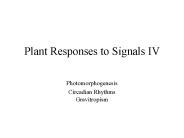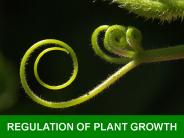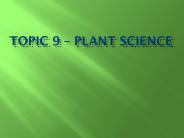Photoperiodic PowerPoint PPT Presentations
All Time
Recommended
Several flowering plants use the pigment phytocrome to sense seasonal changes in ... Cactus spp. Rosaceae Buds. Poppy. Cannnabis. Peyote. Long Day Plants ...
| PowerPoint PPT presentation | free to view
Photoperiodism, Gravitropism, and Thigmotropism AP Biology Unit 5 Photoperiodism How a plant responds (with respect to flowering) to the relative amount of light ...
| PowerPoint PPT presentation | free to view
Raven, Figure 26.10. Day Length Throughout North America. Fosket, Table 9.5 ... Raven, Figure 26.12. Daylength Effects on Flowering. Short day. Long Day ...
| PowerPoint PPT presentation | free to view
Title: PowerPoint Presentation Author: Jan Smalle Last modified by: Jan Smalle Created Date: 9/11/2006 8:13:42 PM Document presentation format: On-screen Show (4:3)
| PowerPoint PPT presentation | free to download
Molecular interactions that shape the plant circadian oscillator ... Hd1 = Heading-date1, rice ortholog of CO. Hd3a = Heading-date 3a, rice ortholog of FT ...
| PowerPoint PPT presentation | free to view
... Events of Germination Auxin and Phototropism Auxin Mechanism Photoperiodic Control of Flowering Phytochrome and Photoperiodism Pfr and Flowering ...
| PowerPoint PPT presentation | free to download
SWBAT differentiate between positive and negative tropisms; describe phototropism and gravitropism; give an example of photoperiodism in plants; discuss nastic ...
| PowerPoint PPT presentation | free to view
Environmental Requirements for Good Plant Growth Photoperiodism short day plants chrysanthemum and Christmas Cactus bloom when days are short and nights are long ...
| PowerPoint PPT presentation | free to download
... Circadian Clock Photoperiodism 1 2 2 3 3 Germination, flowering, bud setting, tuberization, leaf senescence, juvenile to adult transition External factors: ...
| PowerPoint PPT presentation | free to download
Photoperiodism flowering times, Long-day plants, night breaks induce flowering. Short-day plants, night breaks inhibit flowering.
| PowerPoint PPT presentation | free to download
Thigmotropism This plant responds to touch by wilting. What advantage may this be to the plant? Photoperiodism - Some plants respond to the amount of daylight ...
| PowerPoint PPT presentation | free to view
... (24 hour periodicity) Photoperiodism (phytochromes) Short-day plant: light period shorter than a critical length to flower (flower in late summer, ...
| PowerPoint PPT presentation | free to view
Photoperiodism Some plants can accurately measure the length of light and darkness to within minutes so they will flower at precisely the right time of year.
| PowerPoint PPT presentation | free to download
graph of the magnitude of a biological response to light, as a ... FR. light. Phytochrome. photoreceptor molecule. Quantity, Time, Quality. Phytochrome Location ...
| PowerPoint PPT presentation | free to download
the ability of the plant to respond to different lengths of light treatment ... Chenopodium alba 'lamb's quarter' Bud Dormancy. Wareing (1950's) Fagus beech tree ...
| PowerPoint PPT presentation | free to view
Title: Concept Map Author: Jeff Young Last modified by: Jeff Young Created Date: 12/1/2003 8:28:31 PM Document presentation format: On-screen Show Company
| PowerPoint PPT presentation | free to download
Wether = Castrated male sheep. Lamb = Juvenile, male or female sheep. Ewe not as in You! ... Standing heat (Estrus) lasts 1-2 days. Gestation period is 150 days ...
| PowerPoint PPT presentation | free to view
Annual cycles Cuculiformes Cuckoos, roadrunners, and anis 1 family, Cuculidae 138 species Worldwide Pied Cuckoo (from India)
| PowerPoint PPT presentation | free to view
Ethylene:regulates fruit ripening and flowering, responds to stress ... Vernalization (cold induction of flowering) Stratification (cold induction of germination) ...
| PowerPoint PPT presentation | free to download
Plants are able to detect the time of the year or seasons by using the ... floral organs activate and form the organs (sepal, petals, stamens and carpels) ...
| PowerPoint PPT presentation | free to view
... meristem and is found in young leaves and in flowers and fruits ... or flower to drop ... require a specific sequence of day lengths in order to flower ...
| PowerPoint PPT presentation | free to download
All imperfect flowers are incomplete ... stops and then flowering occurs. Indeterminate - elongation growth continues so flowers continue to develop ...
| PowerPoint PPT presentation | free to view
erf: ethylene response factor. no transcription. Light is used by plants as a signal, as well as an energy source, ... Explain the importance of auxin in plants. ...
| PowerPoint PPT presentation | free to download
Figure 36.0 Eucalyptus trees Figure 36.1 An overview of transport in whole plants (Layer 3) Figure 36.1 An overview of transport in whole plants (Layer 4) Figure 36.2 ...
| PowerPoint PPT presentation | free to view
REGULATION OF PLANT GROWTH The external factors affecting plant growth are: light temperature humidity oxygen carbon dioxide soil water ...
| PowerPoint PPT presentation | free to view
Poinsettias are native to Mexico, where the Aztecs used them in the 14th, 15th, and 16th centuries both for medicinal purposes and for making dye.
| PowerPoint PPT presentation | free to view
Photomorphogenesis: 1) phytochrome-mediated development phytochromes - absorb red and far-red light (appear blue) may: trigger seed germination cause deetiolation of ...
| PowerPoint PPT presentation | free to view
Diurnal and circadian rhythms Eva Farre
| PowerPoint PPT presentation | free to download
Plants attract wasps that lay eggs in caterpillars ... A corn leaf recruits a parasitoid wasp as a defensive response to an herbivore, ...
| PowerPoint PPT presentation | free to view
Getting started A. pot immediately after arrival to eliminate stress B. provide shade to reduce heat and light ... space between plants so light ...
| PowerPoint PPT presentation | free to view
Introduction to Plants (cont) Angiosperms are the most dominant phylum . Angiosperms, or flowering plants, produce seeds enclosed inside fruits. Angiosperm comes from ...
| PowerPoint PPT presentation | free to download
Chapter 25 Plant Responses and Adaptations. * * * * * * * * * * * * * * * * * * * * * * * * * * * * * * * * What is a tropism? Tropism ~ a response of a plant to an ...
| PowerPoint PPT presentation | free to view
Title: Lecture #17 Date _____ Author: Chris Hilvert Last modified by: s.moser Created Date: 2/12/2001 3:39:05 PM Document presentation format
| PowerPoint PPT presentation | free to view
Plant Responses and Adaptations Chapter 25: Biology II Plant Hormones Chemical substances that control: A plant s patterns of growth and development A plant s ...
| PowerPoint PPT presentation | free to download
Lecture Date _____ ... germination of seed and bud; stem elongation; leaf growth ... growth/development of roots, leaves, and flowers; senescence Daily and ...
| PowerPoint PPT presentation | free to download
AP Biology Chapter 39 Plant Responses to Internal and External Signals Plant hormones Hormone: chemical signals that coordinate parts of an organism; produced in one ...
| PowerPoint PPT presentation | free to download
dormancy during winter. flowering at appropriate times ... Seed dormancy = mechanism to protect seed from germinating during unfavorable conditions ...
| PowerPoint PPT presentation | free to view
Lesson 1 Examining Parts of a Flower Student Learning Objectives 1. Describe the parts of a flower. 2. Identify the reproductive structures of plants that exist in ...
| PowerPoint PPT presentation | free to view
Antagonistic mechanism b/w auxin and cytokinin. Auxin from the terminal bud restrains axillary bud growth, causing the shoot to lengthen ...
| PowerPoint PPT presentation | free to view
... Pathways A hormone binds to receptor and stimulates secondary messengers which Activates cell responses Plant Movements Phototropism Gravitropism Thigmotropism ...
| PowerPoint PPT presentation | free to download
Plant Hormones & Tropisms Abscisic acid (ABA) Incorrectly named, not related to abscission, slows plant growth Important in drought stress and other stresses Causes ...
| PowerPoint PPT presentation | free to download
... melatonin signal parameters investigated in pinealectomised hamsters ... Mediobasal Hypothalamus Lesion (hamster) Maywood and Hastings 1995. Open circle: MBH-X ...
| PowerPoint PPT presentation | free to view
Plant Reproductive Physiology Stimulus transferred Cut off all leaves after expose to photoperiod inhibit flowering Cut off all leaves 20 -36hrs later promote ...
| PowerPoint PPT presentation | free to view
The art and practice of planning and making plans for the layout and planting of gardens and landscapes is known as garden design. https://www.share.net/SameerShah889372/principles-of-garden-design garden landscaper, garden designer, garden landscape architecture
| PowerPoint PPT presentation | free to download
Plant Hormones Plant tropisms Growth in a particular direction in response to an external stimulus Early experiments Canary grass coleoptiles Classes Hormones Five ...
| PowerPoint PPT presentation | free to view
Ch. 39 Warm-Up Elaborate on the ... Signals Experiments with Light and the coleoptile Excised tip placed on agar block Growth-promoting chemical diffuses into agar ...
| PowerPoint PPT presentation | free to download
... the seedling to bend because one side is growing faster than the other. ... c, Strawberries depend on auxin produced by their developing seeds for expansion ...
| PowerPoint PPT presentation | free to view
6CO2 6H2O ---Light--- C6H12O6 6O2. Respiration ... Shasta Daisy. Spinach. Sugar Beets. Radish. Potted Chrysanthemum. Poinsettia. Shasta Daisy ...
| PowerPoint PPT presentation | free to view
Abscisic Acid Slows or inhibits plant growth.
| PowerPoint PPT presentation | free to view
Rice crop ideally belongs to hot and humid climate and best suited to regions with ... namely, Monsoon, Winter and summer . Climatic Requirements Crop Season ...
| PowerPoint PPT presentation | free to view
1 High cytokinin/auxin ratios favor the formation of shoots. 2 Low cytokinin/auxin ratios favor the formation of roots. Senescence ...
| PowerPoint PPT presentation | free to view
Seedling Development. Etiolated. Dark. long, spindly, white (or yellow) De-Etiolated ... Seedling Development. Monocot. Dark. Monocot. Light. Dicot. Dark. Dicot ...
| PowerPoint PPT presentation | free to view
... ewes (N=16) were housed outdoors at the Sheep Research Facility, University ... Five ewes remained outdoors and served as natural photoperiod controls. ...
| PowerPoint PPT presentation | free to view
Plant Response to Stimuli Stimuli and a Stationary Life Plants, being rooted to the ground Must respond to whatever environmental change comes their way For example ...
| PowerPoint PPT presentation | free to view
Pr: red-light absorbing form of phytochrome, The Pr solution is in blue color ... Se5 is a photoperiod-insensitive early flowering mutant of rice, a SD plant ...
| PowerPoint PPT presentation | free to view
Help seeds break dormancy. Induce biennials to flower in one year (significant in horticulture) ... Stimulates bud scales over buds to prepare them for dormancy. ...
| PowerPoint PPT presentation | free to view
























































